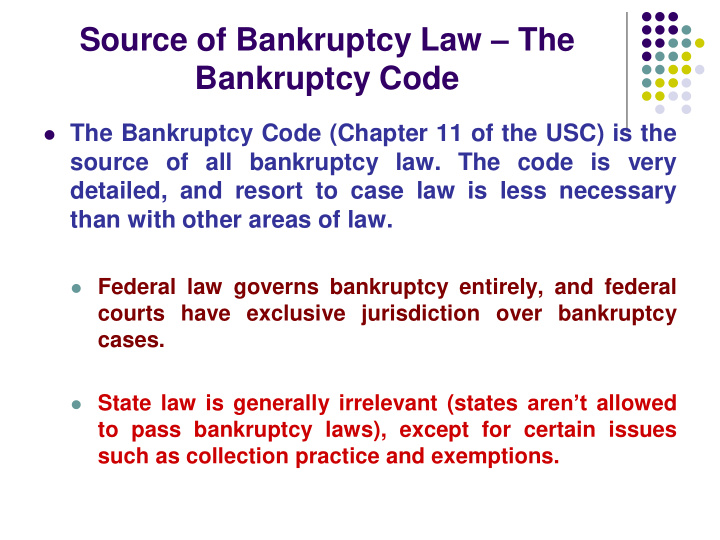



Source of Bankruptcy Law – The Bankruptcy Code The Bankruptcy Code (Chapter 11 of the USC) is the source of all bankruptcy law. The code is very detailed, and resort to case law is less necessary than with other areas of law. Federal law governs bankruptcy entirely, and federal courts have exclusive jurisdiction over bankruptcy cases. State law is generally irrelevant (states aren’t allowed to pass bankruptcy laws), except for certain issues such as collection practice and exemptions.
Structure of Bankruptcy Code The “Code” is divided as follows: Chapter 1: General provisions, parties involved, etc. Chapter 3: Bankruptcy case administration and procedure Chapter 5: Debtor-creditor relationship and the handling of the bankruptcy estate Chapter 7: Liquidation bankruptcy (personal or business) Chapter 9: Municipal (city) bankruptcies Chapter 11: Reorganization bankruptcy (usually businesses) Chapter 12: Special rules of reorganization bankruptcy for farmers Chapter 13: Adjustment of debts for an individual (individuals only)
Parties to a Bankruptcy Proceeding Debtor: the party who is in debt and is seeking bankruptcy protection against creditors’ claims Creditor: a party who is owed money by the debtor Types of creditors: Secured creditor: a creditor who has a security interest in collateral that the debtor possesses. The secured creditor is not usually affected by bankruptcy because the security interest will not be extinguished by the bankruptcy proceeding. Unsecured creditor: a creditor who has no security interest in collateral, and is thus most affected by the bankruptcy proceeding Partially secured creditor: a creditor who owns a security interest in the debtor’s property, but the security interest is not enough to cover all the debts Bankruptcy trustee: the person appointed to manage the debtor’s assets, while the court figures out what to do with them In some cases, the debtor himself could serve as trustee – called the “debtor in possession” (DIP).
Automatic Stay § 362 of the Code As soon as the debtor files for bankruptcy, all debt collection proceedings against her must stop immediately! This even includes: Foreclosures on secured property. Commencing or continuing an action against the debtor. Creating or perfecting a security interest in debtor’s property. Setoffs against the debtor of debts owed to the debtor. Exceptions (these are allowed against the debtor): Criminal actions against the debtor (including getting restitution) Family actions, such as alimony and child support Government actions or judgments Any action taken in violation of the stay is void and must be undone.
Automatic Stay and Adequate Protection The stay lasts until the case is over, but a creditor can ask that the stay be lifted, and it will be lifted 30 days later unless the judge denies that request. creditor’s Grounds for lifting the stay include the demonstrating that he will be irreparably harmed by the stay when the property distribution is made later on. To avoid having the stay lifted, the court or debtor can offer the creditor “Adequate protection” from being hurt by the stay, including: Cash payments to the creditor to compensate for any loss. Giving the creditor additional liens on debtor property.
QUIZ TIME!
Chapter 7: Liquidation This is the best choice when the business is to stop operating, or the individual has no realistic hope of being able to pay off his or her debts. Can be filed voluntarily by the debtor, or can be forced upon the debtor by the creditors (“involuntary filing”) .
Steps in a Chapter 7 Proceeding 1. Filing and automatic stay (filing must be in good faith) 2. Debtor must turn over all property to the trustee, except for exempt property. Exempt property (often governed by state law) includes: Homestead (exemption for part or all of a family home) Important: does not apply to prevent a mortgage foreclosure Personal property necessary to make a living Household property and clothing (must be reasonable) Some levels of income necessary to live on (varies among states) 3. Meeting among all parties; creditors present their claims to the bankruptcy court 4. Distribution to the creditors; some creditors have priority over others. Those with priority include: Bankruptcy administration expenses Wages owed by debtor Secured claims 5. Discharge (the point of the bankruptcy)
Recommend
More recommend